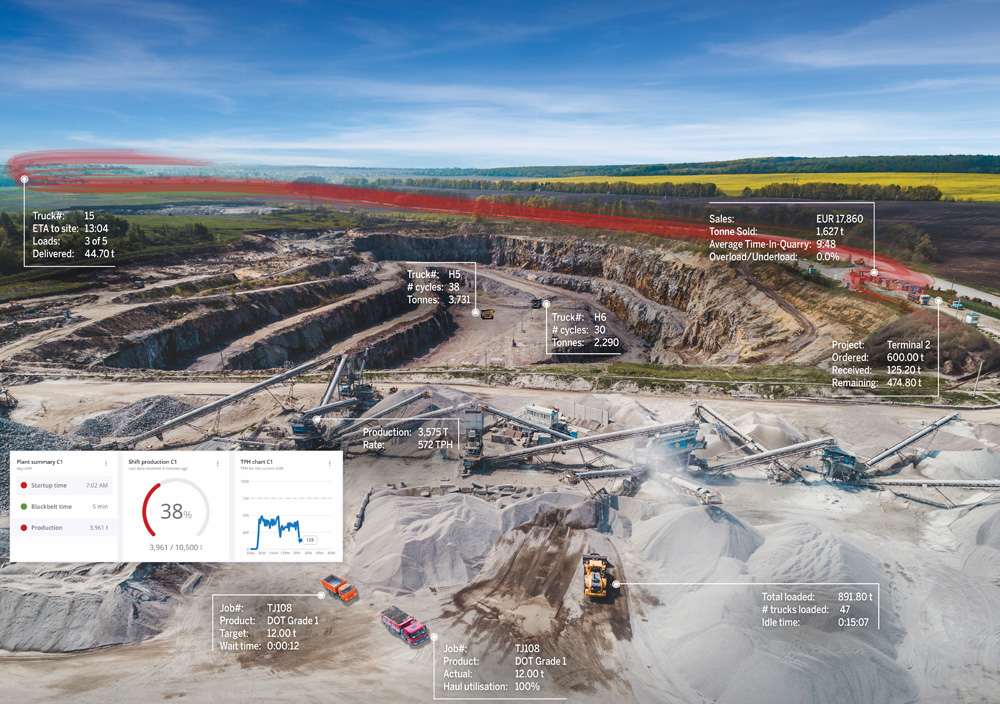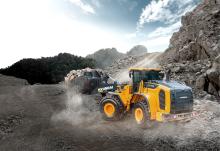
Kevin Garcia has spent his career in the paving and aggregates sector. Out of college, he worked for a cement plant, then moved to Lafarge where he learned all about aggregate and quarrying operations as well as asphalt production and paving, taking on a variety of roles from plant engineer to maintenance engineer. He moved to Trimble in 2012, first as the company’s Paving Segment manager and by 2019, as the general manager of Trimble Civil Specialty Solutions.
In his current role, Garcia manages solutions for aggregate operations, payload management, paving, drilling/piling, landfill construction, lifting solutions, ready mix fleets and marine construction for Trimble. He has seen considerable change in the quarry sector in recent years. “Like every other construction-related sector, aggregates producer management is reliant on good information to drive efficiency and productivity—and sensors are becoming a big part of the process, from extraction to delivery.”
He noted the value across all four of the primary quarry operations. Survey solutions support design, planning, aerial surveying and site control. Machine control sensors on drilling and blasting equipment help operators operate with precision – in some cases to centimetre accuracy. Belt and loader sensors, along with aerial surveys, help operators understand blast yields and stock on hand. And finally, load and haul fleet management systems help operators manage material movement with confidence and accuracy.
But Garcia’s vision goes well beyond these single-point solutions. “While individually, each of these sensors provides value, the real benefit comes when all of that sensor data is tied together,” he said. “Imagine if you could tie your mining production plan to your sales forecast or sync the load management system to your scale house for job data sharing, which results in greater efficiency, improved production to stockpile visibility, higher product sales and significantly improved inventory management.”
He continues: “Data combined in various ways provides insight to production levels, compares target production to reality, and provides operator metrics. For quarries owned by corporations, the technology can connect sites and provide dashboard productivity and benchmark reports to leadership.”

With the evolution of technology, quarry operators with immediate access to see real-time production data and the ability to drill into that data to make better decisions during the shift, have a competitive advantage over those who aren’t yet tapping into this kind of information.
“As a quarry manager, if you can’t tell immediately what happened yesterday or what’s happening right now, you’re already behind,” he said.
One quarry owner told Garcia that competition is really not the issue in his area, so efficiency is not a critical driver. Instead, safety and environmental regulations drive decisions. Garcia explains, “For this owner, opening a new quarry or ramping up production to meet increasing construction demand are the bigger challenges. Once the sensors were installed and the data collected into a dashboard, the owner was able to see some clear and costly inefficiencies.”
“With the comprehensive emphasis on safety and regulatory operations, it’s easy to not notice an inefficiency until it comes through in a monthly report. Good profits hide many sins,” he adds. “Your quarry could be highly profitable, but that doesn’t mean that there aren’t efficiencies to be had.”
“The bottom line is, don’t be fooled by a good balance sheet. It could look better, and your sensors hold the key to better decision making, identifying bottlenecks, determining necessary capital investments and increasing production. How do we apply technology to streamline processes and simplify compliance documentation easier? Technology in a quarry is about a lot more than just machine control or belt sensors—it’s about more informed process management and decision making.”
Charier, for example, is a 123-year-old family business in France that operates in the fields of public works, quarries, and materials recycling. In 2015, the quarry division began implementing continuous improvement processes based on the principles of lean management. Visual management of performance, 5S, flow control, employee feedback and increased monitoring of plant efficiencies helped deliver better productivity and employee satisfaction.
In 2018, the company took it a step further, looking for a way to capture reliable data to make better business decisions, avoid double entries on paper, and increase interest in individual and collective company performance. In 2019, Charier implemented and tested a Trimble LOADRITE solution on the Mariais quarry in Donges in Loire-Atlantique, with an annual production of 600,000 tons of aggregates.
With the equipment on the pit extraction machines - one Liebherr EC700 excavator, two CAT 775 dumpers - the Trimble LOADRITE systems made it possible to capture precise and reliable data on the work of the excavator and the cycle times of the dumpers. The Charier team also used it to determine the number of blocks in shots and thus improve their mine shots. They also equipped the two loaders in the loadout area with the LOADRITE 360 system. This automates the communication between the weighbridge and the loaders, reducing waiting times in the quarry and improving the reliability of the loads.
Finally, with the web-based reporting platform Trimble InisghtHQ, site managers can manage the entire system efficiently, with a real-time vision and simple reports which allow the implementation of actionable insights.
Technology Adoption Options
Despite anecdotal stories, industry studies show that quarry operators have not adopted technology in the way of other market segments, likely for several reasons, according to Garcia. “In many cases, it’s a lack of awareness. We need to do a better job with education and helping owners and operators understand how belt scale sensor data translates beyond simply an operator’s tool. It’s the aggregation of that data that provides operational insight.”
The second reason for the lack of adoption, he says, is limited capital investment and the perceived cost of investment to achieve ROI. And Garcia was quick to note that technology-enabled process management is not only for the large corporate owners. Many quarry owners and operators think they’re too small to make an investment in technology, other than belt scales.
“I would argue that the smaller operators need it even more to compete,” he said. “Smaller operations have fewer personnel and tighter margins. Corporate-owned large production quarries often have a performance group focused on operational efficiencies and can develop best practices that are applied to continuous improvement.”

One quarry manager told Garcia that he’s now able to use sensor-derived data to decide if he needs another pit loader or a different class of machine to keep up with production while minimizing capital investment.
And finally, time is a challenge. Quarries often run multiple shifts a day during the height of construction, and they can’t afford to take equipment down to install sensors.
Garcia recommends the building blocks method. He says, “Start small and build up with an eye on data, not just automation, and you will see ROI very quickly,” he says. “Look for solutions that let you grow as your profits allow. Work with your dealer or service provider to walk your site and identify inefficiencies and plan optimal times for installation. A rainy week is ideal.”
The Connected Quarry: The Way Of The Future
Looking ahead, Garcia sees the benefits of this data beyond the quarry, helping improve the interaction between quarry owners and contractors. “If there is a large civil project coming down the pipeline, imagine how valuable it would be for the quarry operator to have a line of sight to the project progress and provide just-in-time aggregates? The quarry owner can plan for needs without over or underproducing material.”
He also pointed out that technology adoption could well be a tipping point for new talent. The younger generations expect data at their fingertips—if you’re looking to build talent, technology could be a critical draw.
When asked to predict the future, Garcia believes the most significant opportunity lies in Artificial Intelligence (AI)-enabled connected quarries.
“We’ll be able to monitor even more in real-time. Belt scale data and amperage readings from the programmable logic controller (PLC) will be automatically monitored to meet optimal productivity splits. These systems will not just point to a problem, but will also define the problem – such as a worn out liner or high recirculating load,” he said. “The system will automatically tally stones by size, determine floor loss and link that information to transportation and delivery. It will monitor truck and driver activity and optimize hauling and trucking costs. AI-enabled systems will automatically give the operator details about extraction rates and crushing quantities through IoT sensors that are on every piece of equipment. AI improves the quality of production data reporting and actionable recommendations every day, and these tools will only get better as AI systems learn by combining production data with logged recommendations and actions. That’s what we believe the future of the quarry looks like.”
For now, he says, start the investment with an eye on integration. “The more tightly integrated your sensors, the more value you can derive from the data produced today and tomorrow. Begin to see the extraction-to-delivery continuum and the associated metrics and analytics that benchmark performance and daily target rates.”
Garcia says: “We think it’s important to develop solutions, not products. The more tightly integrated the sensors, the more value these systems bring to the entire quarry continuum.”









